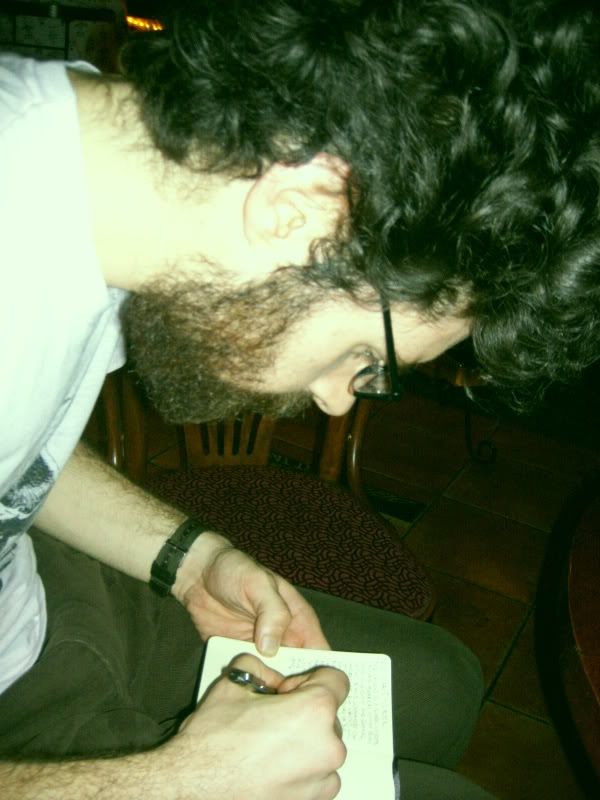Korea is not, strictly speaking, one of the most beautiful places I've ever been. It's mountainous and pleasant, but not in a jaw-dropping, stunning way that parts of the world can be. The scenery is scaled, not fantastic. The mountains are small. The rivers are, for the most part, calm, and you can almost always see some evidence of human existence.
But it's nice to look at. Especially through the window of a moving train. The land kind of folds out around you in a calm, comfortable way. Although you can take a bullet train that will often exceed 200km/h, I've come to prefer the slow train. This is not only for the added reading time, but also for the more accessible view. The major mountains cut north-south along the eastern side of the peninsula, so the trip to Busan (on the southeast corner) is more scenic than the trip to Seoul (in the northwest corner, tucked right in near the DMZ).
Today, however, was a good day for a train ride home from Seoul. This was maybe the third time I have seen fog in Korea, but the hazy air created an interesting feel to the landscape. At first I thought that it reminded me of the Pacific Northwest, but I soon realized it was completely different (and that I was just home(kind of)sick.) For instance, fog in the mighty Columbia Gorge hides or partially masks a dramatic landscape of immense basalt outcroppings, equally immense douglas fir, and magical spraying waterfalls. In Korea, there is nothing so spectacular lurking in the clouds. The fog rather gives a quiet, almost sad feel to the landscape. This is not to say that you can't get a little sad rolling northeast on highway 199 in late November, passing quiet small towns and smoke clouds billowing out the chimneys of school buses-turned-homes. But that is a rugged, cool sadness; a visual expression of the struggle to forge an existence in that towering, wet wonderland. As if a landscape could single handedly demonstrate the character of the Stamper family. In Korea, there is no formidable nature to stand up against, and what there is has been conquered and incorporated into human existence.
Cutting across the northeast corner of the Republic of Korea in a thick fog is like combining the scenery outside of Newark, NJ with the soft, weathered mountains of northern New South Wales. There are rivers. And there are mountains. And there are forests. But there are also many, many factories. Many sites housing enormous pieces of industrial trash; just the kind of iron and steel graveyard that fascinated me as a child. The fog clinging to a sweeping river valley partially obscures the view of a huge, windowless building, itself pushing out clouds of some kind of vapor, which immediately melts into the mist. The factory is not new (has anyone every seen a new, shiny factory? One that doesn't look rusty and heavy with the weight of the world?). And there is a town surrounding the factory. It is not new either. The houses are of the tile-roof, classic east-Asian style, but the roof is more often made of faux-tile corrugated metal. The buildings don't match, and the town looks like it just kind of happened there. Around every bend, or after every tunnel, it's a different factory and town, and the space in between that isn't too steep is all devoted to cascading rice fields. In early February, all the trees are without their leaves, and all the rice fields are a dead brown. Especially in the fog, it all comes together to make you feel quiet, sad, lonely, tired.
When you live in the ritzy part of a young and rapidly developing city, it is easy to think that everything in Korea is tall, new buildings that seem to go up in a matter of weeks, pretty girls in short skirts, and shiny cars. It's not, as a foggy train ride clearly demonstrates. Prosperity is a recent phenomenon, and definitely not one that applies to everyone. The landscape mentioned above shows the recent manufacturing basis of the Korean economy. The forests are not tall or mature, a mix of pine and deciduous trees. A testament to the fact that most of the entire peninsula was flattened and burned in the 1950's.
The foggy air blanketing the huge rusty buildings, small mountains, and low trees doesn't strike you with awe, but it definitely inspires emotion and thought. And that's really what a good landscape does, anyway.
2/8/07
Subscribe to:
Posts (Atom)
